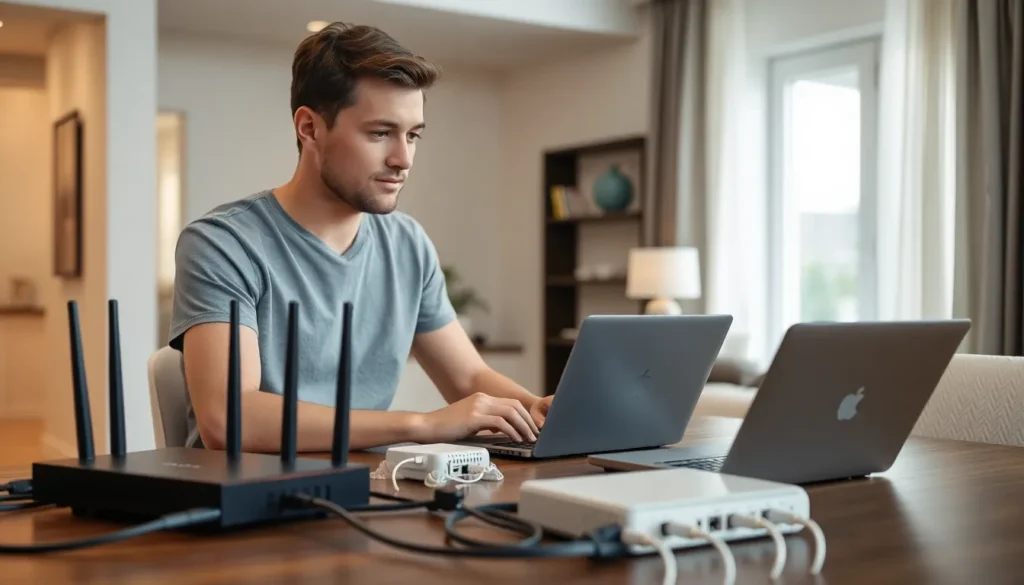In today’s fast-paced world, a reliable home internet setup isn’t just a luxury—it’s a necessity. Whether it’s binge-watching cat videos or attending virtual meetings in your pajamas, a solid connection can make or break the experience. Yet, many find themselves tangled in a web of confusing wires and settings, feeling more like a tech novice than a home network guru.
Table of Contents
ToggleOverview of Home Internet Setup
A home internet setup plays a vital role in maintaining connectivity in everyday life. Reliable internet enables seamless streaming, video conferencing, and online gaming experiences. Setting up a home network begins with selecting an appropriate internet service provider (ISP) that meets specific needs. ISPs offer various plans based on speed, data limits, and pricing.
Modems and routers serve as essential components of a home network. A modem connects the home to the ISP, while a router distributes the internet signal to devices. Choosing a combined modem-router unit can simplify setup while meeting basic demands. Alternatively, purchasing individual devices can enhance performance and provide advanced features.
Wiring organization is another critical aspect. Utilizing Ethernet cables for wired connections ensures stability, particularly for stationary devices like desktops or gaming consoles. Placement of the router should maximize coverage, ideally centralizing it in the home. Obstacles such as walls or large furniture can weaken signal strength, impacting performance.
Wireless standards must also be considered. The latest Wi-Fi 6 technology offers improved speed and capacity, benefiting multiple connected devices. Compatibility with devices is crucial, as older technology may not support newer standards.
Ultimately, a reliable home internet setup facilitates essential activities within the household. Prioritizing the right equipment and configurations contributes to an efficient experience, minimizing frustrations associated with poor connectivity. Evaluating ongoing usage patterns can help optimize the home network over time, catering to evolving needs.
Types of Internet Connections
Multiple types of internet connections suit varying needs and environments. Understanding these options aids in selecting the right service.
DSL vs. Cable
Digital Subscriber Line (DSL) utilizes telephone lines for internet connectivity. It offers consistent speeds suitable for browsing and streaming. Cable connections, on the other hand, employ coaxial cables to deliver higher speeds. Cable tends to excel in speed, accommodating activities like gaming and HD streaming more effectively than DSL. Users often find cable connections share bandwidth with neighbors, potentially leading to slower speeds during peak hours. DSL remains less susceptible to these fluctuations, making it a reliable option if speed isn’t the top priority.
Fiber Optic vs. Satellite
Fiber optic technology employs light signals to transmit data, resulting in extremely high speeds and reliability. This option supports multiple devices streaming simultaneously without disruptions. Satellite internet, while widely available in rural areas, suffers from latency due to signal travel times. Fiber optic connections generally provide superior performance and better upload speeds compared to satellite. Users benefit from lower latency and faster data transfer, making fiber an optimal choice for heavy internet users. Satellite could still serve as a viable alternative when fiber isn’t accessible.
Essential Equipment for Home Internet Setup
A successful home internet setup requires specific essential equipment. Choosing the right devices significantly enhances connectivity and overall performance.
Modems and Routers
Modems connect a home network to the internet while routers distribute that connection to various devices. Many households opt for modem-router combos for simplicity, as they eliminate the need for separate devices. However, individual modems and routers often provide superior performance and flexibility, especially for heavy users. A quality modem supports the highest speed tiers offered by an ISP, ensuring consistent throughput. Routers equipped with Wi-Fi 6 technology offer enhanced coverage and speed, catering to multiple devices seamlessly.
Network Extenders
Network extenders improve Wi-Fi coverage in larger homes or areas with connectivity issues. These devices relay signals from the main router, boosting coverage in dead spots. An appropriate extender can significantly enhance streaming and online gaming experiences. Many modern extenders come with easy setup options, allowing for quick installation. Some units even provide mesh networking capabilities, creating a unified network without dead zones. Understanding the layout and size of a home ensures proper placement of network extenders for optimal performance.
Steps to Set Up Home Internet
Setting up home internet involves careful planning and execution. Following a few key steps simplifies the process and enhances connectivity.
Choosing the Right Location
Prioritizing router placement significantly impacts signal strength. Position the router in a central location for even coverage throughout the home. Avoid placing it near walls or large metal objects that interfere with the signal. Elevating the router can enhance range as well. Ensuring the device remains unobstructed promotes optimal performance. If a multi-story home exists, consider placing a second router or extender on the upper floors for better coverage. Checking the speed and reliability in various areas of the home during this phase can guide adjustments, if necessary.
Configuring Your Network
Selecting a strong password protects the network from unauthorized access. Access the router settings through a web browser using the provided IP address. Setting up the network name or SSID makes it easier for family members to identify the correct connection. Configuring security settings, such as WPA3 encryption, enhances safety against potential threats. Adjusting other settings, like enabling Quality of Service (QoS), prioritizes bandwidth for essential applications, ensuring smooth streaming or gaming experiences. Regularly updating the router’s firmware helps maintain security and performance, keeping the network efficient over time.
Troubleshooting Common Issues
Home internet setups can encounter several issues that disrupt connectivity and performance. Understanding how to resolve these problems significantly enhances the user experience.
Connection Drops
Connection drops can frustrate anyone relying on a stable internet connection. Start by checking the modem and router; ensure all cables are securely connected. Next, examine the network’s signal strength. If it’s weak, consider relocating the router closer to devices needing a strong connection. Overloaded networks can also cause drops, especially when multiple devices are connected. Disconnect unused devices to free up bandwidth and improve stability. Lastly, firmware updates for routers may resolve persistent connection issues.
Slow Internet Speeds
Experiencing slow internet speeds often frustrates users during streaming or gaming. First, run a speed test to gauge actual performance. If results are significantly below the subscribed speed, reboot the modem and router. Network congestion often causes slowdowns, particularly during peak hours, so scheduling heavy usage during off-peak times may help. In some cases, older equipment can limit speeds; upgrading to a newer router can alleviate this issue. Checking for background applications consuming bandwidth can also provide clarity. Configuring Quality of Service settings allows prioritizing essential applications, ensuring they have the necessary bandwidth for optimal performance.
Establishing a reliable home internet setup is essential for modern living. By selecting the right ISP and investing in quality equipment, individuals can enhance their online experience significantly. Proper placement of routers and organization of wiring plays a crucial role in ensuring optimal connectivity.
Staying informed about the latest technologies like Wi-Fi 6 and understanding different types of internet connections empowers users to make informed decisions. Regular evaluations and adjustments to the network can further improve performance. With the right approach, anyone can enjoy a seamless and frustration-free internet experience at home.





